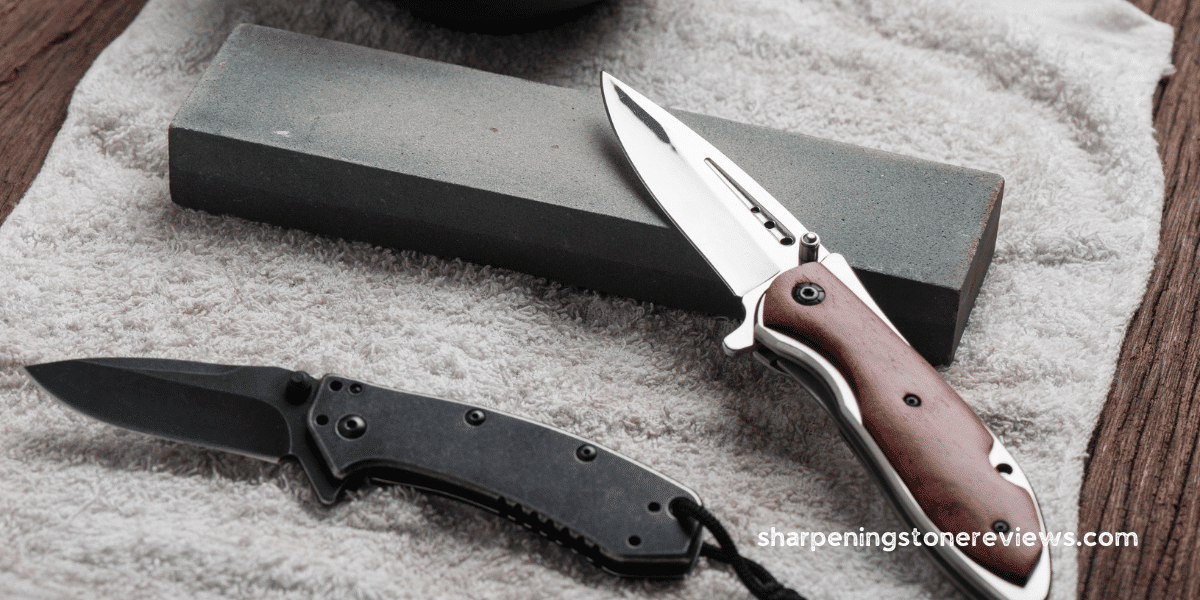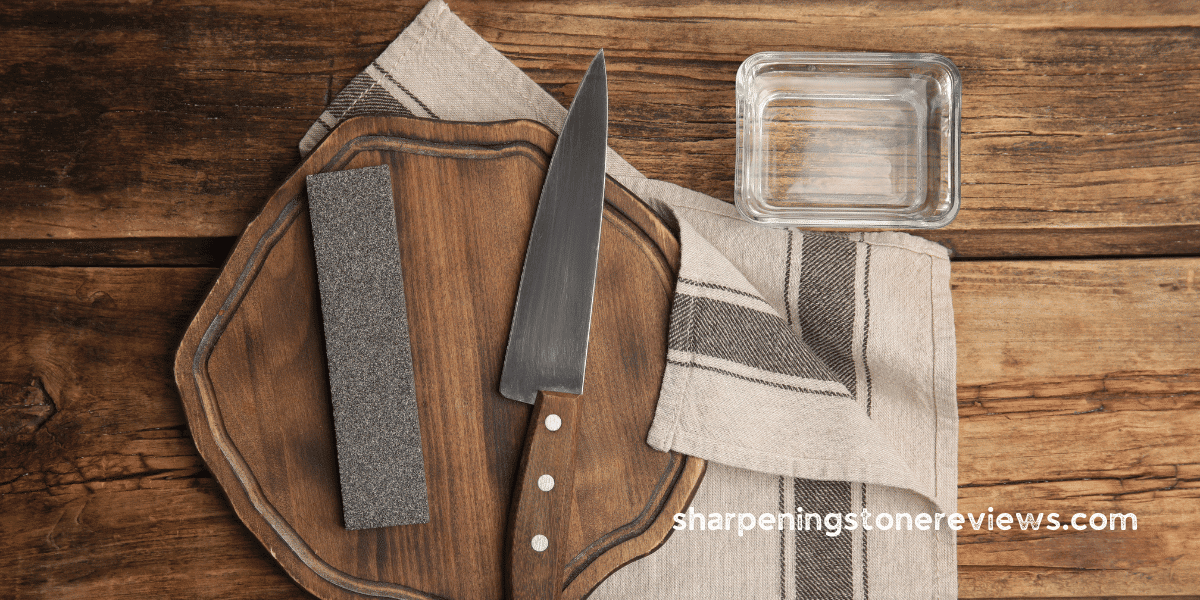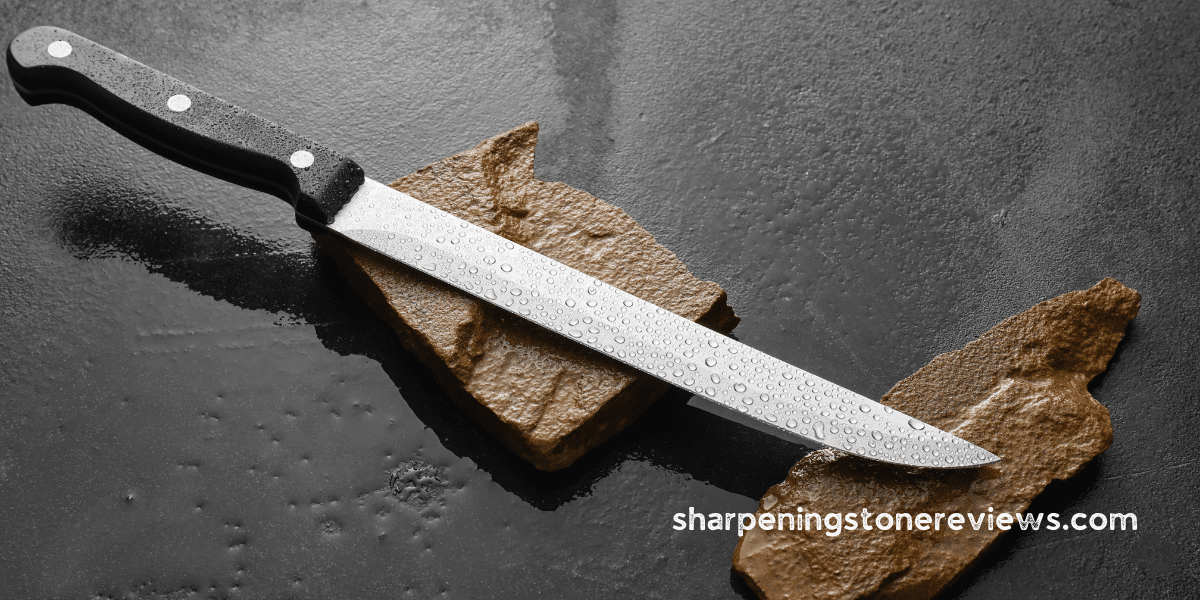Are you tired of dull tools slowing down your progress? Look no further than Shapton Glass Stones! These remarkable sharpening tools will transform your blades from lackluster to razor-sharp in no time.
Prepare to be amazed as you witness the power of these stones, designed with precision and efficiency in mind. Say bye to frustration and hello to effortless sharpening.
Follow our expert guide on how to use Shapton Glass Stones and unlock a world of sharpness like never before.
Get ready to take your skills to new heights!
Soak the stones
To properly use the Shapton Glass Stones, you should soak them in water for 6 to 10 minutes before starting. Soaking the stones is essential as it allows the water to penetrate the stone’s surface, ensuring that it remains moist throughout the sharpening process. The water acts as a lubricant, reducing friction between the gritstone and the blade being sharpened.
Waterstones like the Shapton Glass Stones are made from abrasive particles suspended in a bonding material. These glass stones have a uniform particle size, which allows for consistent sharpening results. When soaked in water, these particles become activated and create a slurry on the stone’s surface.
Soaking also helps to prevent excessive wear on both the stone and the blade. The water acts as a coolant, dissipating heat generated during sharpening and preventing damage to both surfaces. It also helps to wash away any metal shavings or debris that may clog up the stone’s pores.
When soaking your Shapton Glass Stones, ensure that you do not leave them in water for too long. Leaving them submerged for an extended period can cause surface softening and reduce their effectiveness. Once you’ve completed your sharpening session, let the stones dry thoroughly before storing them in their provided plastic box.
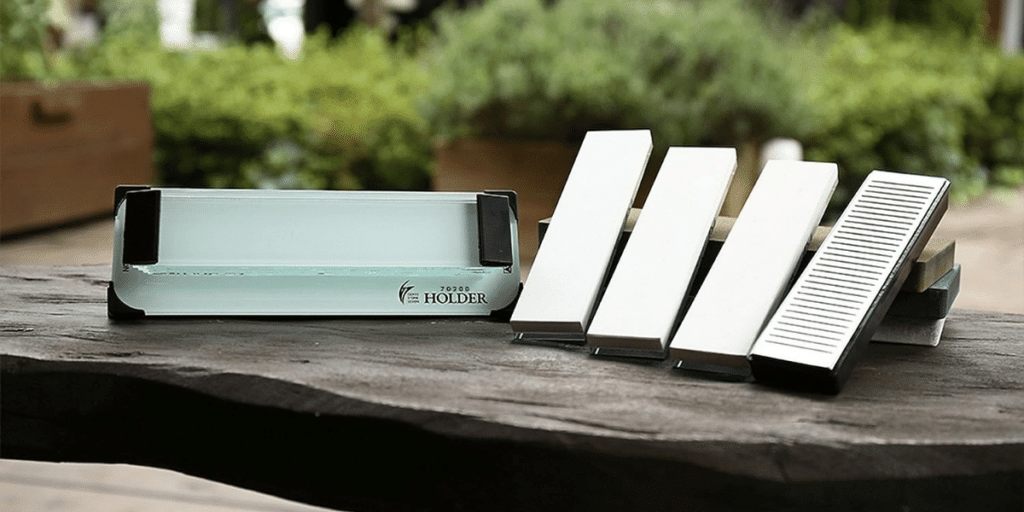
Set up workbench
After preparing the sharpening stone, discard the soft plastic lining in the box. This will ensure a clean and unobstructed surface for your sharpening needs.
Now, let’s set up your workbench for using Shapton Glass Stones.
First, find a stable and flat work surface to place your stone on. It should be large enough to accommodate the size of the stone and provide ample space for maneuvering your knives. A sturdy table or countertop will suffice.
Next, gather all the necessary materials for this process. You will need your Shapton Glass Stones, which are known for their excellent quality and durability. These stones are made from high-quality glass stock that is carefully sourced and manufactured to provide consistent results.
Place a non-slip mat or grip pad underneath your stone to prevent it from moving during use. This will ensure stability and safety while sharpening.
Now, take one of your Shapton Glass Stones out of its protective plastic case and soak it in water for 6 to 10 minutes before use. This step is crucial as it allows the abrasive particles within the stone to become fully saturated with water, enhancing their cutting performance.
Once soaked, remove any excess water from the surface of the stone before placing it on your workbench. The wet surface will create a slurry when combined with knife steel, aiding in smooth sharpening.
Remember to always start with coarser grits when working on dull edges and gradually progress towards finer grits for polishing and refining purposes.
With these steps, you are now ready to begin using your Shapton Glass Stones on various knives’ edges. Remember to maintain proper technique throughout each sharpening session and regularly clean your stones after use.
Happy sharpening!
Choose grit sequence
For optimal sharpening results, it’s important to choose the appropriate grit sequence when using Shapton Glass Stones. Sharpening stones come in various grit levels, ranging from coarse to fine. The grit level refers to the size of the abrasive particles on the stone’s surface, also known as grain size.
When selecting a grit sequence, start with a coarser stone to remove any nicks or dullness on the blade. This initial step will help establish a new edge before progressing to finer stones. A common sequence is to start with a 1000-grit stone, followed by a 3000-grit stone, and then finish with an even finer 8000-grit stone.
The coarser stones have larger abrasive particles that can quickly shape the edge and remove more material. As you progress to finer stones, the grain size decreases, resulting in a smoother finish on the blade. The finer stones help refine and polish the edge for superior sharpness.
It’s essential to use lighter pressure when sharpening with finer stones, as they are designed for polishing rather than aggressive material removal. Remember to maintain consistent angle and stroke direction throughout the sharpening process for best results.
Apply water or oil.
When sharpening your tools and knives, remember to apply water or oil to the surface of your Shapton Glass Stone for optimal performance. Water stones like the Shapton Glass Stone are designed to be used with water, as it helps to lubricate the stone and remove any metal particles that may accumulate on its surface during sharpening. By applying water or oil, you ensure that the abrasive particles on the stone are able to effectively do their job.
To begin, soak the Shapton Glass Stone in water for a few minutes before use. This allows the stone to absorb enough moisture so that it can provide a consistent cutting action. You can use either hot or cold water, depending on your preference. Once soaked, place the stone on a stable surface and start sharpening by moving your tool or knife across the entire surface of the stone.
It is important to continuously apply water or oil while sharpening to keep the stone adequately lubricated. This not only enhances its cutting efficiency but also prevents overheating of your tool’s edge. Remember to regularly wet the stone throughout your sharpening process.
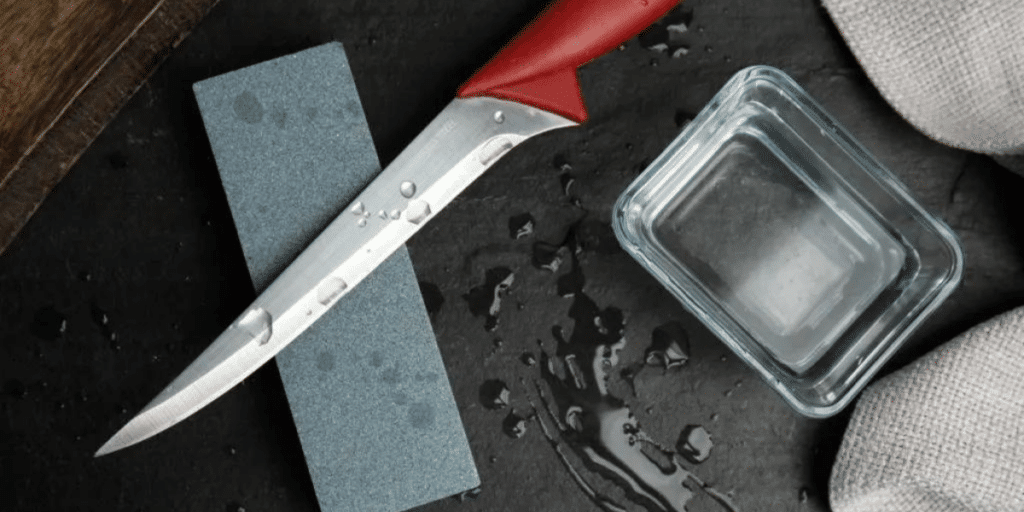
Hold stone securely
To hold your stone securely while sharpening, make sure to grip it firmly with your hand. This will ensure stability and prevent any accidents or mishaps during the sharpening process.
Here are three important factors to consider when holding your Shapton Glass Stone:
- Level Base: Place the stone on a level and stable surface. This will provide a solid foundation for sharpening and prevent any unnecessary movement or wobbling.
- Grip Strength: Hold the stone with a firm grip using your hand. This will give you better control over the stone and help maintain consistent pressure while sharpening.
- Glass Backing Plate: If you’re using a Shapton Glass Stone, it comes with a glass backing plate. Make sure to secure the stone onto the plate properly before use. The glass backing plate provides additional stability and helps keep the stone flat during sharpening.
By following these guidelines, you can ensure that your Shapton Glass Stone stays securely in place while sharpening, allowing you to achieve optimal results on your steel tools or knives.
Properly holding the stone is crucial for maintaining its mirror finish and maximizing its effectiveness as an abrasive material for edge maintenance. So remember to grip it firmly, use a level base, and secure it onto a glass backing plate if necessary.
Maintain consistent pressure
Maintaining consistent pressure while sharpening is essential for achieving optimal results on your tools or knives. When using Shapton Glass Stones, it is crucial to maintain steady and even pressure throughout the sharpening process. This ensures that the blade edge is properly honed and avoids any uneven wear or damage to the stone.
To maintain consistent pressure, start by securely holding the tool or knife in one hand and the Shapton Glass Stone in the other. Place the stone on a stable surface, such as a countertop or workbench. Apply lightly downward pressure with your fingers, making sure not to put too much force as it can cause uneven wear on the stone.
As you begin sharpening, move the tool along the length of the stone using smooth and controlled strokes. Keep your hand steady and maintain an even amount of pressure throughout each stroke. This will help to ensure that you are evenly sharpening both sides of the blade.
It’s important to note that different tools may require varying amounts of pressure. For example, heavier blades like chisels may require slightly more pressure than lighter blades like kitchen knives. Take some time to experiment and find what works best for each specific tool.
Use proper angle
Achieving precise and effective sharpening results requires using the proper angle when sharpening your tools or knives. The angle at which you hold the blade against the Shapton Glass stone can make a significant difference in the outcome of your sharpening process. The Shapton Glass stones are known for their high-quality abrasive agents that provide excellent edge sharpness. To ensure optimal results, it’s crucial to maintain a consistent angle throughout the sharpening process.
When using the Shapton Glass stones, it is recommended to use a lapping plate to flatten and prepare the surface of the stone before starting. This will help create an even and smooth surface for sharpening. As you begin sharpening, it is important to maintain a circular motion while moving the blade across the stone. This circular motion helps create a uniform scratch pattern on the blade, resulting in a sharper edge.
To achieve the best results with these stones, it is essential to pay attention to your technique and maintain a steady hand. Start by holding your tool or knife at an angle between 15 and 20 degrees against the stone’s surface. Apply light pressure as you move the blade in a circular motion along its entire length.
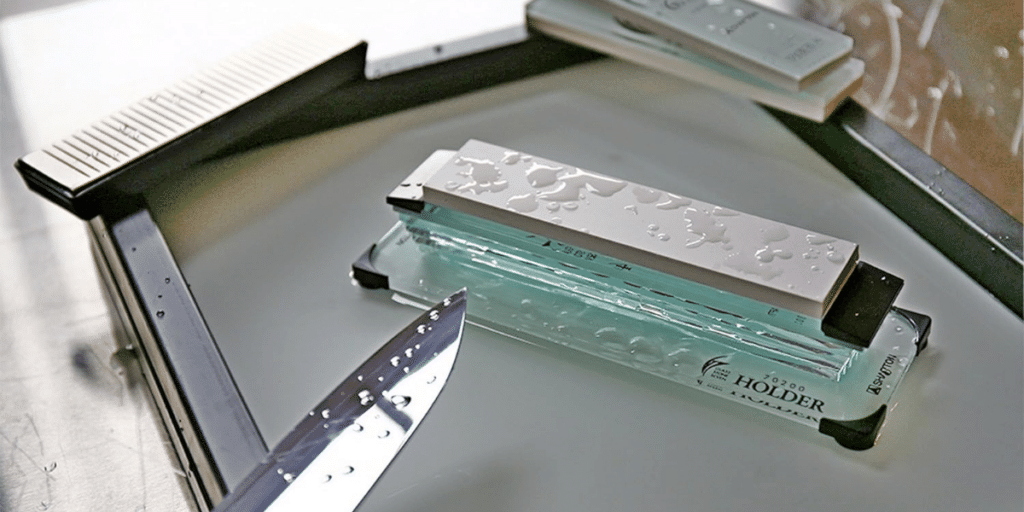
Sharpen both sides
When sharpening your tools or knives with Shapton Glass Stones, it is crucial to alternate between both sides for even and consistent results. These high-quality glass stones are renowned for their exceptional sharpening capabilities. They come in various grit levels, ranging from coarse to finer grits, allowing you to achieve the desired level of sharpness.
To start the sharpening process, select a stone based on the current condition of your tool or knife. If there are major nicks or damage, begin with a coarser grit-level stone to remove the imperfections. Move the tool or knife back and forth along the stone’s surface, applying gentle pressure.
Once you have achieved a satisfactory result with the coarse grit level stone, switch to a finer grit level stone for further refinement. Repeat the alternating motion on both sides of the blade to ensure uniformity.
It is important to note that when using these glass stones, always follow recommended guidelines provided by Shapton Glass HR Stones. Additionally, make sure you properly maintain and store these stones after each use.
Clean after use
To keep your tools in top condition, it’s important to clean the sharpening stone after each use. This is especially true when using Shapton Glass Stones, as they are known for their high-quality and effective sharpening capabilities. Cleaning the stone not only removes any particles or debris that may have accumulated during use but also helps maintain its performance and longevity.
Here are four steps to properly clean your Sharpton Glass Stone:
Rinse with water
After using the stone, rinse it thoroughly under running water to remove any traces of metal particles or slurry. Make sure to use cool water, as hot water can damage the stone.
Use a mild detergent (optional)
If the stone is particularly dirty or has stubborn stains, you can use a small amount of mild detergent. Gently scrub the surface of stone with a soft brush or sponge, then rinse thoroughly.
Dry completely
After cleaning, allow the stone to air dry completely before storing it. Avoid using heat sources like hair dryers, as this can cause thermal shock and potentially crack the stone.
Store properly
Once dry, store your Shapton Glass Stone in a clean and dry place. It’s recommended to store it in its original box or wrap it in cloth or paper towel to protect it from scratches and other potential damages.
Store stones properly
It’s important to properly store your sharpening stones after use to protect them from scratches and potential damage. When it comes to storing your Shapton Glass Stones, there are a few key considerations to keep in mind.
First, make sure to let the stone dry completely before storing it. This help prevent any moisture from seeping into the stone and potentially causing damage over time.
Next, ensure that you store your sharpening stone in a clean and dry environment. Avoid storing it near any particles or debris that could scratch the surface of the stone. It’s also a good idea to store your stones in their original plastic box or case, as this will provide extra layer of protection.
When selecting a storage location for your sharpening stones, try to find an area where they won’t be easily knocked over or bumped. This will help prevent accidental damage that could occur during storage.
If you have multiple sharpening stones, consider stacking them on top of each other with a soft cloth or towel between each one. This will help keep them organized and further protect them from scratches.
Lastly, if you have a thinner stone, such as the Shapton Glass Stone HR or ceramic sharpening stones, take extra care when handling and storing them. These types of stones can be more fragile compared to thicker natural stones, so it’s important to handle them with caution.
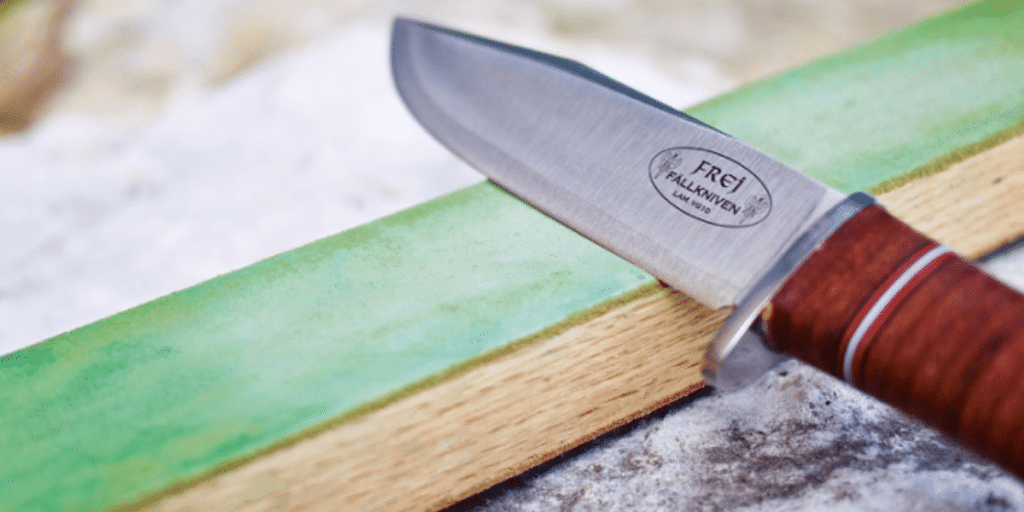
Frequently Asked Questions
How Long Should I Soak the Shapton Glass Stones Before Use?
Soak the Shapton Glass Stones in water for 6 to 10 minutes before use. Avoid leaving them in water for too long to prevent surface softening. Properly prepare the edge with finer stones beforehand.
Can I Use Oil Instead of Water to Lubricate the Stones?
No, you should not use oil to lubricate the Shapton Glass Stones. They are designed to be used with water for optimal sharpening results. Using oil can negatively affect the performance and effectiveness of the stones.
What Is the Recommended Way to Hold the Stone Securely While Sharpening?
To hold the stone securely while sharpening, grip it firmly with your non-dominant hand, placing your fingers on the sides for stability. Make sure you have a comfortable and balanced grip to maintain control throughout the sharpening process.
How Often Should I Clean the Stones During the Sharpening Process?
During the sharpening process, clean the stones regularly to remove the slurry and prevent cross-contamination. This ensures optimal results by maintaining a clean working surface. Cleaning frequency depends on usage, but aim for every few minutes or when necessary.
Are There Any Specific Tips for Sharpening Curved or Serrated Blades Using Shapton Glass Stones?
When sharpening curved or serrated blades using Shapton Glass Stones, ensure the stone is flat and use a gentle, rocking motion. Start with coarser grit to shape the blade. Maintain the edge by regularly honing with finer stones.
Final Thoughts
In conclusion, using Shapton Glass Stones for sharpening tools is a skill that requires attention to detail and technique. By following instructions provided, you can achieve exceptional results in sharpening your tools.
Just like an artist meticulously crafting a masterpiece on canvas, sharpening with Shapton Glass Stones allows you to bring out the true potential of your tools.
With proper stone preparation, maintenance, and sharpening techniques, you can create edges so sharp they cut through materials like hot knife through butter.
So dive into the world of Shapton Glass Stones and unlock the artistry of precision sharpening!
